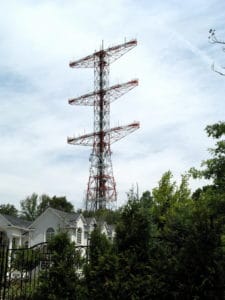A Divine Comedy
By Mark Schubin 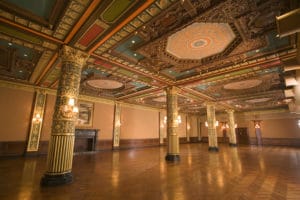
The Prince George Ballroom (right) is a highly appropriate location for On Site Opera’s production of Giacomo Puccini’s comic opera Gianni Schicchi. The opera takes place largely in a room of a Florentine palace; the Prince George Ballroom is decorated in an opulent Neo-Renaissance style. The opera’s world premiere was at the Metropolitan Opera House during the 1918 pandemic; the ballroom, a short walk from that site, had been completed not long before.
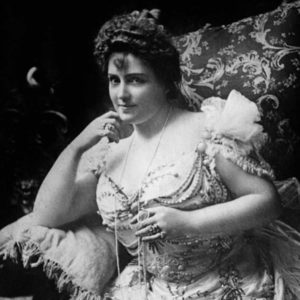
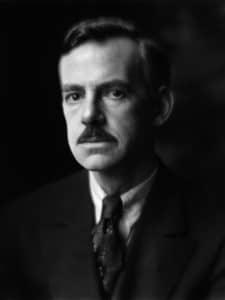 The ballroom was also a very operatic location on its own. One of the people who could be found at what was then called the Main Lounge was comic opera star Lillian Russell (left), who had once graced the stage of the Met, and her companion, Diamond Jim Brady. Another was playwright Eugene O’Neill (right), several of whose works have been turned into operas.
The ballroom was also a very operatic location on its own. One of the people who could be found at what was then called the Main Lounge was comic opera star Lillian Russell (left), who had once graced the stage of the Met, and her companion, Diamond Jim Brady. Another was playwright Eugene O’Neill (right), several of whose works have been turned into operas.
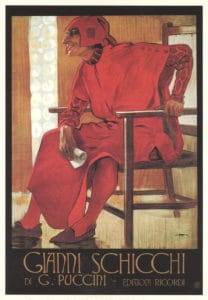 O’Neill’s only well-known comedy, Ah, Wilderness!, was made into a musical twice but (it appears) not yet into an opera. Gianni Schicchi is Puccini’s only comic opera; the composer more often dealt with tragedy. Gianni Schicchi (1919 poster by Leopoldo Metlicovitz, left) was the third short Puccini opera to premiere the same day and place. The first ends with murder, the second with suicide. Gianni Schicchi begins with a natural death and ends happily. But Jan Hoffman wrote in The New York Times that, when the hotel had fallen on hard times, “Throughout the 1980’s, hell’s embassy in Manhattan was the Prince George on East 28th Street.” And even that makes it an appropriate location for Gianni Schicchi.
O’Neill’s only well-known comedy, Ah, Wilderness!, was made into a musical twice but (it appears) not yet into an opera. Gianni Schicchi is Puccini’s only comic opera; the composer more often dealt with tragedy. Gianni Schicchi (1919 poster by Leopoldo Metlicovitz, left) was the third short Puccini opera to premiere the same day and place. The first ends with murder, the second with suicide. Gianni Schicchi begins with a natural death and ends happily. But Jan Hoffman wrote in The New York Times that, when the hotel had fallen on hard times, “Throughout the 1980’s, hell’s embassy in Manhattan was the Prince George on East 28th Street.” And even that makes it an appropriate location for Gianni Schicchi.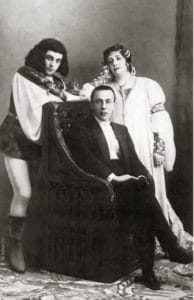
The three short Puccini operas, known collectively as Il trittico [The Triptych], are often performed together. They were the last operas completed by the composer (Turandot was incomplete when he died). When the Princeton Festival produced Gianni Schicchi in 2012, however, it was performed not with the other Il trittico operas but with Rachmaninoff’s opera Francesca da Rimini; the composer of that opera is shown (seated) with some of the cast from the 1906 premiere at the Bolshoi Theater in Moscow at right. And that pairing was appropriate, too. Dozens of composers have created operas based on Francesca’s story. Rachmaninoff’s version had a libretto by Modest Tchaikovsky, younger brother of the famous composer.
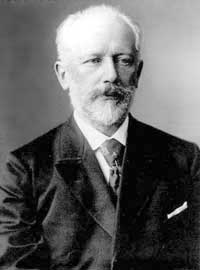
New York’s Museum of Sex is very close to the Prince George Ballroom. Not far in a different direction is the Radio Wave Building, so named because it was the home of inventor Nikola Tesla (right) when he experimented with radio. In 1903, the U.S. Patent Office rejected Guglielmo Marconi’s application for a radio patent because of prior Tesla patents; in 1904, the year the Prince George Hotel opened, they reversed the decision (and, after Tesla’s death, the Supreme Court reversed the reversal).
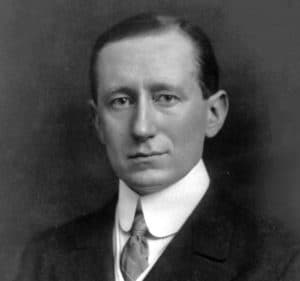
One of the most unusual radio antenna towers, looking like a giant power pylon (right, photo by Ww2censor), may be seen from New York atop the New Jersey palisades. It was the site of the world’s first FM radio station to begin regular operations, created by Edwin Armstrong, another pioneering radio inventor. In 1939, its first publicized transmission included Tchaikovsky’s Francesca da Rimini, sent from WQXR’s studios over a special high-fidelity circuit.

Given that the 1918 flu pandemic was raging when Gianni Schicchi had its premiere, Manhattan might have seemed somewhat hellish back then, too. The Times story that mentioned that nickname, however, was about the building’s change from an outpost of hell to one of heaven. It was headlined “Rebuilding Lives While Reviving Buildings.” It was about the work that the organization now called Breaking Ground does “to strengthen individuals, families and communities by developing and sustaining exceptional supportive and affordable housing as well as programs for homeless and other vulnerable New Yorkers.”
If the name of the organization seems familiar, it might be because On Site Opera has also partnered with them on productions of Gian Carlo Menotti’s Amahl and the Night Visitors. They do good work. And think about whether the work Gianni Schicchi does in the opera really deserves condemnation to perdition. At the very least, On Site Opera’s production is one hell of a good time!

